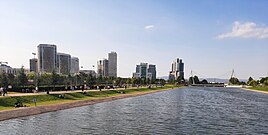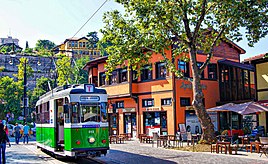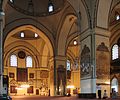Bursa
You can help expand this article with text translated from the corresponding article in Turkish. (October 2020) Click [show] for important translation instructions.
|
Bursa | ||
|---|---|---|
City | ||
Clockwise from top: Hüdavendigar Park; Green Mosque; Irgandı Bridge and Orhan Gazi Square; nostalgic tram on Cumhuriyet Avenue; Koza Han; and Bursa – Mt. Uludağ gondola lift | ||
|
Licence plate 16 | | |
| Website | www.bursa.bel.tr | |
Europe | ||
Bursa (Turkish pronunciation:
Bursa was the first major and second overall capital of the Ottoman State between 1335 and 1363. The city was referred to as Hüdavendigar (خداوندگار, meaning "God's Gift" in Ottoman Turkish, a name of Persian origin) during the Ottoman period, while a more recent nickname is Yeşil Bursa ("Green Bursa") referring to the parks and gardens located across the city, as well as to the vast, varied forests of the surrounding region.
Bursa has a rather orderly urban growth and borders a fertile plain. The
The shadow play characters Karagöz and Hacivat are based on historic personalities who lived and died in Bursa in the 14th century.[3]
History

The earliest known human settlement near Bursa's current location was at Ilıpınar Höyüğü around 5200 BC.
Under Byzantine rule, the town became a garrison city in 562 AD, where imperial guards were stationed there. Already by the mid-6th century, Bursa was known as a famous silk textile manufacturing centre.[6]
Bursa (from the Greek "Prusa") became the first major capital city of the early
| Year | Pop. | ±% |
|---|---|---|
| 1487 | 45,000 | — |
| 1927 | 61,451 | +36.6% |
| 1955 | 128,875 | +109.7% |
| 1980 | 487,604 | +278.4% |
| 2000 | 1,184,144 | +142.8% |
| 2015 | 1,854,285 | +56.6% |
During the Ottoman period, Bursa continued to be the source of most royal
In July 1915, thousands of Greek Orthodox Christians sought refuge in Bursa after having been forced out of their coastal villages by orders of the

Following the foundation of the
The city has traditionally been a pole of attraction, and was a major centre for refugees from various ethnic backgrounds who immigrated to
Geography
The area covered by Bursa corresponds to 1.41% of
Climate
Bursa has a Mediterranean climate (Köppen climate classification: Csa) under the Köppen classification, and a dry-hot summer subtropical climate (Csa) under the Trewartha classification. The city has hot, dry summers that last from June until September. Winters are cool and damp, also containing the most rainfall. There can be snow on the ground which will last for a week or two. Air pollution is a chronic problem in Bursa.[22]
| Climate data for Bursa (1991–2020, extremes 1928–2023) | |||||||||||||
|---|---|---|---|---|---|---|---|---|---|---|---|---|---|
| Month | Jan | Feb | Mar | Apr | May | Jun | Jul | Aug | Sep | Oct | Nov | Dec | Year |
| Record high °C (°F) | 25.2 (77.4) |
26.9 (80.4) |
32.5 (90.5) |
36.2 (97.2) |
37.0 (98.6) |
41.3 (106.3) |
43.8 (110.8) |
42.6 (108.7) |
40.3 (104.5) |
37.3 (99.1) |
32.1 (89.8) |
27.3 (81.1) |
43.8 (110.8) |
| Mean daily maximum °C (°F) | 9.8 (49.6) |
11.4 (52.5) |
14.6 (58.3) |
19.2 (66.6) |
24.4 (75.9) |
28.9 (84.0) |
31.5 (88.7) |
31.7 (89.1) |
27.6 (81.7) |
22.2 (72.0) |
16.6 (61.9) |
11.5 (52.7) |
20.8 (69.4) |
| Daily mean °C (°F) | 5.4 (41.7) |
6.5 (43.7) |
9.0 (48.2) |
13.0 (55.4) |
18.1 (64.6) |
22.6 (72.7) |
25.1 (77.2) |
25.2 (77.4) |
20.8 (69.4) |
15.9 (60.6) |
10.7 (51.3) |
7.0 (44.6) |
14.9 (58.8) |
| Mean daily minimum °C (°F) | 1.7 (35.1) |
2.4 (36.3) |
4.1 (39.4) |
7.4 (45.3) |
12.0 (53.6) |
16.2 (61.2) |
18.4 (65.1) |
18.7 (65.7) |
14.8 (58.6) |
10.8 (51.4) |
6.0 (42.8) |
3.3 (37.9) |
9.6 (49.3) |
| Record low °C (°F) | −20.5 (−4.9) |
−19.6 (−3.3) |
−10.5 (13.1) |
−4.2 (24.4) |
0.8 (33.4) |
4.0 (39.2) |
8.3 (46.9) |
7.6 (45.7) |
3.3 (37.9) |
−1.0 (30.2) |
−8.4 (16.9) |
−17.9 (−0.2) |
−20.5 (−4.9) |
| Average precipitation mm (inches) | 79.2 (3.12) |
78.2 (3.08) |
74.9 (2.95) |
68.6 (2.70) |
47.9 (1.89) |
42.8 (1.69) |
14.3 (0.56) |
17.5 (0.69) |
50.1 (1.97) |
84.4 (3.32) |
67.3 (2.65) |
93.9 (3.70) |
719.1 (28.31) |
| Average precipitation days | 14.87 | 13.60 | 13.40 | 11.43 | 9.63 | 7.30 | 3.33 | 3.60 | 6.77 | 10.67 | 10.93 | 14.53 | 119.8 |
| Average relative humidity (%)
|
75.3 | 72.8 | 70.7 | 69.3 | 67.1 | 63.1 | 59.6 | 61.7 | 67.3 | 74.6 | 75.5 | 75.7 | 69.4 |
| Mean monthly sunshine hours | 83.7 | 90.4 | 124.0 | 165.0 | 217.0 | 264.0 | 300.7 | 275.9 | 217.0 | 145.7 | 111.0 | 77.5 | 2,071.9 |
| Mean daily sunshine hours | 2.7 | 3.2 | 4.0 | 5.5 | 7.0 | 8.8 | 9.7 | 8.9 | 7.0 | 4.7 | 3.7 | 2.5 | 5.6 |
| Source 1: Turkish State Meteorological Service[23][24] | |||||||||||||
| Source 2: NOAA (humidity)[25]
| |||||||||||||
Economy

Bursa is the largest production centre of the
Apart from its large automotive industry, Bursa also produces a substantial amount of dairy products (by Sütaş),[27] processed food (by Tat),[28] and beverages (by Uludağ).[29]

Traditionally, Bursa was famous for being the largest centre of silk trade in the Byzantine and later the Ottoman empires, during the period of the lucrative Silk Road. The city is still a major centre for textiles in Turkey and is home to the Bursa International Textiles and Trade Centre (Bursa Uluslararası Tekstil ve Ticaret Merkezi, or BUTTIM). Bursa was also known for its fertile soil and agricultural activities, which have decreased in the recent decades due to the heavy industrialization of the city.
Bursa is a major centre for tourism. One of the most popular
Transportation
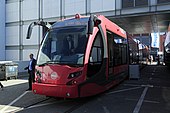
Bursa has a metro (Bursaray), trams[30] and a bus system for inner-city public transport, while taxi cabs are also available. Bursa's Yenişehir Airport is 20 mi (32 km) away from the city centre. The citizens of Bursa also prefer Istanbul's airports such as Istanbul Airport and Sabiha Gökçen International Airport for flights to foreign countries, due to Istanbul's proximity to Bursa. There are numerous daily bus and ferry services between the two cities.

The 8.8 km (5.5 mi) long Bursa Uludağ Gondola (Turkish: Teleferik) connects Bursa with the ski resort areas 1,870 m (6,140 ft) high on the mountain Uludağ.[31]
The only railway station in Bursa is the Harmancık station on the Balıkesir-Kütahya railway, which was opened in 1930.
The average amount of time people spend commuting with public transit in Bursa, for example to and from work, on a weekday is 62 min. 12% of public transit riders ride for more than 2 hours every day. The average amount of time people wait at a stop or station for public transit is 18 min, while 31% of riders wait for over 20 minutes on average every day. The average distance people usually ride in a single trip on public transit is 8.1 km (5.0 mi), while 17% travel for over 12 km (7.5 mi) in a single direction.[32]
Education
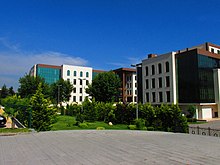
Bursa has two public universities and one private university.
The first private university in Bursa was the Bursa Orhangazi University,[35] which started education in the 2012–2013 academic year. However, Orhangazi University was shut down by the Turkish government after the failed coup attempt of July 2016.
Istanbul Commerce University has opened graduate programs in Bursa in 2013.[36]
The vocational high schools, Bursa Sports High School,[37] and Bursa Agriculture Vocational High School,[38] are located in Osmangazi district.
Sports
The city has one professional football club,
Bursaspor plays its home games at the
The city has a professional
Politics
Bursa district Municipalities Local elections, 2024 | |
|---|---|
| AKP | 9 / 17
|
| CHP | 6 / 17
|
| IYIP | 2 / 17
|
The current Mayor of the Bursa Metropolitan Municipality Mustafa Bozbey is elected from the main opposition party (CHP) in March 2024.
Alinur Aktaş from the Justice and Development Party (AKP) was in office between 2019 and 2024, the AKP coalition won 49.6% of the vote against the CHP coalition which got 47% of the vote.[39]
Main sights
Ulu Cami (Grand Mosque)
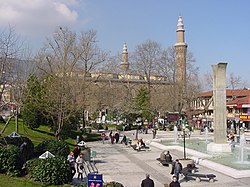
Ordered by Sultan Bayezid I, the mosque was designed and built by architect Ali Neccar in 1396–1400. It is a large and rectangular building, with a total of twenty domes that are arranged in four rows of five, and are supported by 12 columns. Supposedly the twenty domes were built instead of the twenty separate mosques which Sultan Bayezid I had promised for winning the Battle of Nicopolis in 1396. The mosque has two minarets.
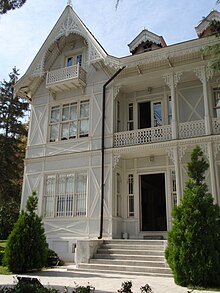
Inside the mosque, there are 192 monumental wall inscriptions written by the famous
The horizontally spacious and dimly lit interior is designed to feel peaceful and contemplative. The subdivisions of space formed by multiple domes and pillars create a sense of privacy and even intimacy. This atmosphere contrasts with the later Ottoman mosques (see for example the works of Suleiman the Magnificent's chief architect, Mimar Sinan.) The mosques that were built after the conquest of Constantinople (Istanbul) by the Ottoman Turks in 1453, and influenced by the design of the 6th century Byzantine basilica of Hagia Sophia, had increasingly elevated and large central domes, which create a vertical emphasis that is intended to be more overwhelming; to convey the divine power of Allah, the majesty of the Ottoman Sultan, and the governmental authority of the Ottoman State.
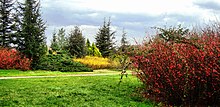

Places of interest
A brief list of the places of interest in and around Bursa is presented below. For a longer list, see the places of interest in Bursa.
Mosques and külliye complexes
- Bursa Grand Mosque and külliye
- Yeşil Mosqueand külliye
- Bayezid I Mosque and külliye
- Muradiye Mosque and külliye
- Emir Sultan Mosque and külliye
- Orhan Gazi Mosque and külliye
- Hüdavendigar Mosque and külliye
- Koca Sinan Paşa Mosque and külliye
- İshak Paşa Mosque and külliye
- Karacabey Grand Mosque
- Karabaş-i Veli Cultural Centre
- Somuncu Baba Mosque
- Üftade Tekkesi Mosque and complex
- BabasultanMosque and complex
Bazaars and caravanserais
Other historic monuments
- Bursa Castle
- Irgandı Bridge
- İnkaya Sycamore, a massive and impressive 600-year-old tree (Platanus orientalis)
Museums
- Bursa Archaeological Museum
- Bursa Atatürk Museum,[40]
- Bursa City Museum,[41]
- Bursa Energy Museum
- Bursa Forestry Museum
- Bursa Karagöz Museum
- Bursa Museum of Turkish and Islamic Art
- Bursa Turkish Architecture Museum
- İznik Museum
- Mudanya Armistice House
- Museum of Ottoman House
- Tofaş Museum of Cars and Anatolian Carriages
Parks and gardens
- Uludağ National Park
- Bursa Zoo and Botanical Garden
- Bursa Hüdavendigar Kent Park
Hot springs and thermal baths
- Keramet hot spring
- Çekirge hot spring
- Armutlu hot spring
- Oylat hot spring
- Gemlik hot spring
- Çelik Palas thermal bath
Beaches
- Armutlu beach
- Kumla beach
- Kurşunlu beach
- Orhangazi beach
- Mudanya beach
- Manastir beach
- Kapakli beach
Jewish community
Bursa, initially home to a small Romaniote Jewish community, underwent a demographic shift with the arrival of Sephardic Jews who were expelled from the Iberian Peninsula in the late 15th century. The Sephardic majority quickly absorbed the Romaniotes, leading to a cultural and numerical dominance. Judaeo-Spanish became the daily language, and the community paid its poll tax through the representative, the kahya.[42]
Throughout the Ottoman period, most Jews resided in Kuruçeşme, Bursa's Jewish quarter, home to three synagogues. Etz Chaim (Eṣ Ḥayyim), the oldest, predated Ottoman conquest, while the Gerush and Mayor synagogues were established by Sephardic newcomers. Despite the 1851 fire destroying Etz Chaim, the other two remain, along with the Berut synagogue. Bursa also had a Jewish cemetery until recently.[42]
Though never a major center, Bursa's Jewish population fluctuated. Dubious data suggests 683 families in 1571/72, dropping to 141 by 1696/97. By 1883, there were 2,179 Jews, with an influx of 400 from Akkerman in 1887. Pre-World War I, the population reached 3,500, but emigration reduced it to 140 by the early 21st century.[42]
Engaged in the local economy, Bursa's Jews were shop owners and involved in guilds. In the 16th and 17th centuries, they excelled in textile manufacturing, silk trade, goldsmithing, and finance. Despite economic struggles in the 18th and 19th centuries, a 1886 report highlighted poverty.[42]
Bursa faced blood libels in 1592 and 1865. Despite its size, the community produced renowned halakhic scholars across centuries. Modern schooling arrived in 1886 with Alliance Israélite Universelle, but it closed in 1923 during the secularization program. Jewish children then attended Turkish schools for a modern education.[42]
Gallery
-
Bursa Citadel Main Gate
-
Orhan GaziMosque
-
Entrance of theYeşil Cami(Green Mosque)
-
Muradiye Mosque and Külliye in Bursa
-
Governorate of Bursa
-
Mt. Uludağ is a popular ski destination.
-
Statue of Atatürk in Bursa
-
Şehreküstü Mosque
-
Interior of Yeşil Mosque
-
Bursa French Catholic Church
-
Saltanatkapı (Citadel Main Gate)
-
Old City Hall
-
Tophane Clocktower
-
Tomb ofOsman Gazi
-
Tomb ofOrhan Gazi
-
Interior of the Grand Mosque
-
Koza Han (Silk Bazaar)
-
A view of Bursa in the late 19th century
-
Bursa, circa 1895
-
Atatürk delivering a speech in Bursa, 1924
-
A view of Bursa from the foothills of Mt. Uludağ
Twin towns – sister cities
 Darmstadt, Germany (1971)
Darmstadt, Germany (1971) Sarajevo, Bosnia and Herzegovina (1972)
Sarajevo, Bosnia and Herzegovina (1972) Oulu, Finland (1978)
Oulu, Finland (1978) Kairouan, Tunisia (1987)
Kairouan, Tunisia (1987) Anshan, China (1991)
Anshan, China (1991) Bitola, North Macedonia (1996)
Bitola, North Macedonia (1996) Ceadîr-Lunga, Moldova (1997)
Ceadîr-Lunga, Moldova (1997) Kyzylorda, Kazakhstan (1997)
Kyzylorda, Kazakhstan (1997) Mascara, Algeria (1998)
Mascara, Algeria (1998) Kulmbach, Germany (1998)
Kulmbach, Germany (1998) Pleven, Bulgaria (1998)
Pleven, Bulgaria (1998) Plovdiv, Bulgaria (1998)
Plovdiv, Bulgaria (1998) Tirana, Albania (1998)
Tirana, Albania (1998) Košice, Slovakia (2000)
Košice, Slovakia (2000) Vinnytsia, Ukraine (2004)
Vinnytsia, Ukraine (2004) Szentendre, Hungary (2005)
Szentendre, Hungary (2005) Pristina, Kosovo (2010)
Pristina, Kosovo (2010) Bakhchysarai, Ukraine (2010)
Bakhchysarai, Ukraine (2010) Momchilgrad, Bulgaria (2010)
Momchilgrad, Bulgaria (2010) Mogilev, Belarus (2013)
Mogilev, Belarus (2013) Hebron, Palestine (2014)
Hebron, Palestine (2014) Herzliya, Israel (2014)
Herzliya, Israel (2014) Veliko Tărnovo, Bulgaria (2017)
Veliko Tărnovo, Bulgaria (2017) Galkayo, Somalia (2018)
Galkayo, Somalia (2018)
See also
- 1855 Bursa earthquake
- Complex of Mehmed I
- Emirsultan Mosque
- Grand Mosque of Bursa
- Green Tomb and Mosque
- List of people from Bursa
- List of World Heritage Sites in Turkey
- Siege of Bursa
References
- ^ a b "Bursa (Metropolitan Province, Turkey) - Population Statistics, Charts, Map and Location".
- ^ "Statistics by Theme > National Accounts > Regional Accounts". www.turkstat.gov.tr. Retrieved 11 May 2023.
- ^ "Karagöz'ün Tarihçesi".
- ISBN 9062580734.
- ^ "British Museum - Collection search: You searched for Bursa, tomb". British Museum. Retrieved 25 May 2015.
- ^ ISBN 9781576079195.
- ^ "In 1363 the Ottoman capital moved from Bursa to Edirne, although Bursa retained its spiritual and economic importance." Ottoman Capital Bursa. Official website of the Ministry of Culture and Tourism of the Republic of Turkey. Retrieved 19 December 2014.
- ^ "Bayezid I Complex". ArchNet. Archived from the original on 2011-05-25. Retrieved 2009-06-28.
- ^ "Great Mosque of Bursa". ArchNet. Archived from the original on 2011-09-19. Retrieved 2009-06-28.
- ^ Mohammad Habib, Khaliq Ahmad Nizami, A Comprehensive History Of India Vol.-V: The Delhi Sultanat (1970), p. 128
- ^ The city in the Islamic world, Volume 1, ed. Salma Khadra Jayyusi, Renata Holod, Attilio Petruccioli, André Raymond, page 362.
- S2CID 244587800.
- ISSN 0041-4255.
- ^ "Armenian trade networks".
- ^ Lowry, Heath W. (2003). Ottoman Bursa in Travel Accounts. Indiana University. p. 1.
- OCLC 1026510365.
- OCLC 1236894121.)
{{cite book}}: CS1 maint: others (link - ^ Μουστάκης, Βασίλειος Δ. (2000). Λόγια του κανονιέρη. 1079 μέρες συνοδοιπόροι με το θάνατο! (in Greek). New York, USA. p. 64.
Στον σταθμό, είχαν περάσει τα Πεζικά και είχαν βάλει φωτιά. Είδαμε έναν έφιππο, Άγγλο στρατηγό, που διέταξε να σβήσουν τη φωτιά, γιατί αν καιγόταν η Προύσα, θα ήταν εις βάρος της Ελλάδος
{{cite book}}: CS1 maint: location missing publisher (link) - ^ Eminov, Ali, Turks and Other Muslim Minorities in Bulgaria, New York, Routledge, 1997, Höpken, W., "Modernisierung und Nationalismus: Sozialgeschichtliche Aspekte der bulgarischen Minderheitenpolitik gegenüber den Türken" in: SOE 7-8 (1986), Schönfeld, R., ed, Nationalitätenprobleme in Südosteuropa, Munich, Oldenbourg, 1997, p. 255-303, Erdinç, Didar, "Bulgaristan'daki Değişim Sürecinde Türk Azınlığın Ekonomik Durumu", Türkler, Ankara, 2002, s.394–400.
- ^ "Present and future Köppen-Geiger climate classification maps at 1-km resolution". Nature Scientific Data. DOI:10.1038/sdata.2018.214.
- ^ GLHN (2022-07-23). "Bursa - Coğrafya". Gülhan Sözlük (in Turkish). Archived from the original on 2023-01-30. Retrieved 2023-01-30.
- ^ Kara Rapor 2020: Hava Kirliliği ve Sağlık Etkileri [Black Report 2020: Air Pollution and Health Effects] (PDF) (Report) (in Turkish). Right to Clean Air Platform Turkey. August 2020. Archived (PDF) from the original on 2022-10-09.
- ^ "Resmi İstatistikler: İllerimize Ait Mevism Normalleri (1991–2020)" (in Turkish). Turkish State Meteorological Service. Retrieved 24 April 2021.
- ^ "İllerimize Ait Genel İstatistik Verileri" (in Turkish). Turkish State Meteorological Service. Retrieved 11 April 2024.
- National centers for Environmental Information. Retrieved 2 August 2023.
- ^ "Turkey: A centre of excellence in automotive industry". Automotive Meetings Turkey. Retrieved 3 October 2020.
- ^ "Sütaş Süt Ürünleri A.Ş." Retrieved 25 May 2015.
- ^ "Tat". Retrieved 25 May 2015.
- ^ Uludağ Beverages
- ^ DVV Media UK. "Bursa circular tramway opens". Railway Gazette. Archived from the original on 24 September 2015. Retrieved 25 May 2015.
- ^ "GD8 Bursa I + II + III - References - Company - LEITNER ropeways". www.leitner-ropeways.com. Archived from the original on 2016-10-12. Retrieved 2016-09-14.
- ^ "Bursa Public Transportation Statistics". Global Public Transit Index by Moovit. Retrieved June 19, 2017.
 Material was copied from this source, which is available under a Creative Commons Attribution 4.0 International Licence.
Material was copied from this source, which is available under a Creative Commons Attribution 4.0 International Licence.
- ^ "Uludağ Üniversitesi Hakkında". Uludağ Üniversitesi Resmi Websitesi.
- ^ "Bursa Teknik Üniversitesi". Btu.edu.tr. Retrieved 2013-03-26.
- ^ "Bursa Orhangazi Üniversitesi". Bou.edu.tr. Archived from the original on 2013-03-18. Retrieved 2013-03-26.
- ^ "Istanbul Commerce University at Bursa" (in Turkish). Archived from the original on 2012-08-27.
- ^ "Bursa Celal Sönmez Spor Lisesi, geleceğin şampiyonlarını arıyor". Bursada Bugün (in Turkish). 14 June 2020. Retrieved 20 June 2021.
- ^ "Kültür Envanteri Anıt - Tarım Meslek Lisesi - Bursa" (in Turkish). Türkiye Kültür Portalı. 13 May 2013. Retrieved 4 February 2023.
- ^ "Bursa Seçim Sonuçları - 31 Mart Bursa Yerel Seçim Sonuçları". www.haberler.com (in Turkish). Retrieved 2021-08-15.
- ^ "Bursa - Atatürk Museum".
- ^ "Bursa City Museum". Archived from the original on 2019-10-20. Retrieved 2019-04-11.
- ^ a b c d e Bornstein-Makovetsky, Leah. "Bursa". In Stillman, Norman A. (ed.). Encyclopedia of Jews in the Islamic World. Brill Reference Online.
- ^ "Kardeş Şehirler". bursa.bel.tr (in Turkish). Bursa. Retrieved 2022-01-06.

